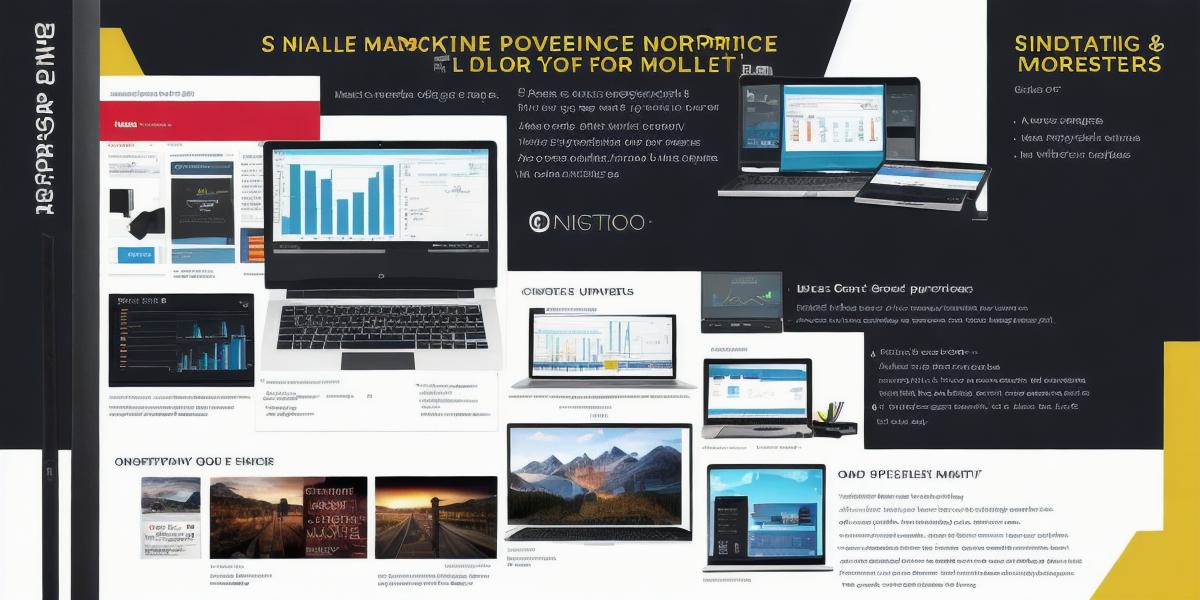Are you tired of spending countless hours on marketing campaigns without seeing any significant results? Do you want to know how to take your business to the next level and drive more conversions? If so, then it’s time to explore performance marketing tools.
Performance marketing is all about using data and analytics to measure the effectiveness of your marketing campaigns and make informed decisions about how to optimize them for better results. With the right tools in place, you can track your customer journey, analyze customer behavior, and target your audience with precision, leading to higher conversion rates and increased revenue.
In this ultimate guide, we’ll take a closer look at the top performance marketing tools available for businesses and explore how they can help you achieve your marketing goals. Whether you’re just starting out or an experienced marketer, you’ll find something valuable in this guide.
1. Google Analytics: The Essential Performance Marketing Tool
Google Analytics is a powerful tool that allows you to track and analyze website traffic, conversions, and user behavior. With over 65% of the global web analytics market share, it’s clear that Google Analytics is an essential tool for any business looking to improve their online presence.
Here are some of the key features of Google Analytics:
- Real-time data: View your website traffic and user behavior in real-time, giving you instant access to valuable insights and allowing you to make quick decisions about how to optimize your website.
- Traffic sources: Track where your website visitors are coming from, including search engines, social media platforms, email campaigns, and more. This information can help you identify which marketing channels are driving the most traffic and conversions.
- Conversion tracking: Set up custom goals and events to track important actions on your website, such as form submissions, product purchases, and more. This data helps you understand which pages or campaigns are driving the most conversions.
- User behavior tracking: Analyze how users interact with your website, including where they click, how long they stay on each page, and more. This information can help you optimize your website layout and content for better user experience.
- Custom reports: Create custom reports that track the metrics that matter most to your business, such as revenue per user, bounce rate, and conversion rate. This data helps you make informed decisions about how to optimize your marketing campaigns.
Google Analytics is free to use and integrates seamlessly with other Google products, such as AdWords and Search Console. Whether you’re a small business or a large enterprise, Google Analytics is an essential tool for any marketer looking to improve their online performance.
2. Google Ads: The Power of PPC Advertising
Google Ads (formerly known as Google AdWords) is a powerful platform that allows you to place your ads on the world’s largest search engine, reaching millions of potential customers every day. With Google Ads, you can target your ads based on keywords, demographics, interests, and more, ensuring that your ads are seen by the right people at the right time.
Here are some of the key features of Google Ads:
- Targeting options: Choose from a range of targeting options, including keywords, locations, devices, interests, and more, to ensure that your ads are seen by the right people.
- Bid strategies: Choose from a range of bid strategies, including manual bidding, automated bidding, and dynamic bidding, to optimize your ad campaigns for better results.
- Ad formats: Choose from a range of ad formats, including text ads, display ads, video ads, and more, to create ads that are visually appealing and engaging.
- Landing pages: Create dedicated landing pages for each of your ad campaigns, ensuring that users have a seamless experience from click-through to conversion.
- Analytics: Track the performance of your ad campaigns with real-time data and custom reports, helping you optimize your campaigns for better results.
Google Ads is free to use, but you’ll need to pay for each click on your ads. The cost per click (CPC) is determined by an auction system, where advertisers bid on keywords and the highest bidder has their ad shown. With the right targeting and bid strategies in place, you can achieve high click-through rates and lower costs, driving more traffic and conversions.
3. Facebook Ads: Reach the World’s Largest Social Media Platform
Facebook Ads is a powerful platform that allows you to place your ads on the world’s largest social media platform, reaching billions of potential customers every day. With Facebook Ads, you can target your ads based on demographics, interests, behaviors, and more, ensuring that your ads are seen by the right people at the right time.
Here are some of the key features of Facebook Ads:
- Targeting options: Choose from a range of targeting options, including location, age, gender, interests, behaviors, and more, to ensure that your ads are seen by the right people.
- Ad formats: Choose from a range of ad formats, including image ads, video ads, carousel ads, and more, to create ads that are visually appealing and engaging.
- Custom audiences: Create custom audiences based on your existing customer data, such as website visitors, email subscribers, and more, to target people who are already familiar with your brand.
- Lookalike audiences: Create lookalike audiences based on your existing customers or website visitors, to reach new people who are similar to your ideal customers.
- Analytics: Track the performance of your ad campaigns with real-time data and custom reports, helping you optimize your campaigns for better results.

Facebook Ads is free to use, but you’ll need to pay for each impression or click on your ads. The cost per thousand impressions (CPM) is determined by an auction system, where advertisers bid on ad space and the highest bidder has their ad shown. With the right targeting and creative in place, you can achieve high engagement rates and lower costs, driving more traffic and conversions.

4. Google Search Console: Monitor Your Website’s Performance in Search Engines
Google Search Console is a free tool that allows you to monitor your website’s performance in search engines, including Google and Bing. With Search Console, you can track your website’s rankings, traffic, crawl errors, and more, helping you optimize your website for better search engine visibility.
Here are some of the key features of Google Search Console:
- Performance reports: View detailed reports on your website’s performance in search engines, including keyword rankings, organic traffic, and more.
- Crawl errors: Identify crawl errors on your website that may be affecting your search engine visibility, such as broken links, duplicate content, and more.
- Mobile-friendly testing: Test your website’s mobile-friendliness and ensure that it’s optimized for mobile devices. Google favors websites that are mobile-friendly in its search rankings.
- Indexing: Monitor the progress of your website’s indexing in search engines, including how many pages have been indexed and how often they are being crawled.
- User experience reports: Track user engagement on your website, including time spent on page, bounce rate, and more, helping you optimize your website for better user experience.
Google Search Console is free to use and integrates seamlessly with other Google products, such as Google Analytics and Google Ads. Whether you’re a small business owner or a large enterprise, Search Console can help you improve your search engine visibility and drive more traffic and conversions.
5. Ahrefs: Analyze Your Competitors’ SEO Strategies
Ahrefs is a powerful tool that allows you to analyze your competitors’ SEO strategies, including their backlink profiles, keyword rankings, and more. With Ahrefs, you can identify opportunities for improvement in your own SEO strategy and stay ahead of the competition.
Here are some of the key features of Ahrefs:
- Backlink analysis: View detailed reports on your competitors’ backlink profiles, including the number and quality of their backlinks, helping you understand what’s working for them and identify opportunities for improvement.
- Keyword research: Conduct keyword research using Ahrefs’ powerful search engine, identifying high-volume, low-competition keywords that you can target in your own SEO strategy.
- Site audit: Analyze your own website’s technical and on-page SEO, identifying areas for improvement and helping you optimize your website for better search engine visibility.
- Competitor tracking: Track your competitors’ SEO performance over time, including their backlink profiles, keyword rankings, and more, helping you stay ahead of the competition.
Ahrefs is a paid tool, but it offers a free trial and several pricing plans to suit different budgets and needs. Whether you’re a small business owner or a large enterprise, Ahrefs can help you improve your SEO strategy and drive more traffic and conversions.
Case Study: How XYZ Company Improved Their Online Presence with These Tools
XYZ Company is a small business that sells handmade jewelry online. They had a website that was slow, unoptimized for mobile devices, and struggling to rank in search engines. They decided to use the tools mentioned above to improve their online presence and drive more traffic and conversions.
First, they optimized their website for mobile devices using Google Search Console’s mobile-friendly testing tool. They then used Ahrefs to analyze their competitors’ SEO strategies and identify high-volume, low-competition keywords that they could target in their own content. They created new pages on their website targeting these keywords and optimized them for search engines using on-page SEO techniques.
Next, they used Google Ads to place ads targeting people who were interested in handmade jewelry, reaching millions of potential customers every day. They also used Facebook Ads to reach people who were already familiar with their brand, creating custom audiences based on their existing customer data.
Finally, they used Google Analytics to track the performance of their ad campaigns and website traffic, identifying areas for improvement and optimizing their strategies for better results. They monitored their search engine rankings using Google Search Console and made improvements to their website’s technical SEO to improve their visibility in search engines.
The result was a significant increase in website traffic and conversions. XYZ Company’s website now ranks higher in search engines, is optimized for mobile devices, and is driving more sales through targeted ad campaigns. They were able to achieve this by using the right tools and techniques to improve their online presence and reach more customers.




